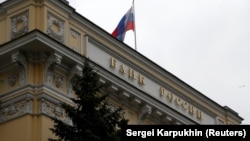Russia’s central bank has increased its main interest rate for the first time in four years amid a tightening of Western sanctions and accelerating inflation.
The Bank of Russia said on September 14 that it had raised its key rate by a quarter of a percentage point, to 7.5 percent, and that it would "consider the necessity of further increases in the key rate," which is used to determine the cost of credit, as "annual inflation is returning to 4 percent faster than expected."
The rate hike comes with emerging markets such as Turkey seeing their currencies in crisis, and as the West threatens fresh sanctions against Russia.
In August, the ruble fell to a two-year low against the U.S. dollar.
"The Bank of Russia will consider the necessity of further increases in the key rate, taking into account inflation and economic dynamics against the forecast, as well as risks posed by external conditions and the reaction of financial markets," the bank said in a statement.
The bank forecasts annual inflation in the range of 5 to 5.5 percent in 2019 before it slows to 4 percent in 2020.
The interest rate was last raised during a 2014 crisis sparked by falling oil prices and the imposition of Western sanctions over Russia's annexation that year of the Crimea region from Ukraine.
The central bank's latest rate hike immediately pushed up the value of the ruble against the dollar to about 68 from around 69 to the U.S. currency earlier in the week.












